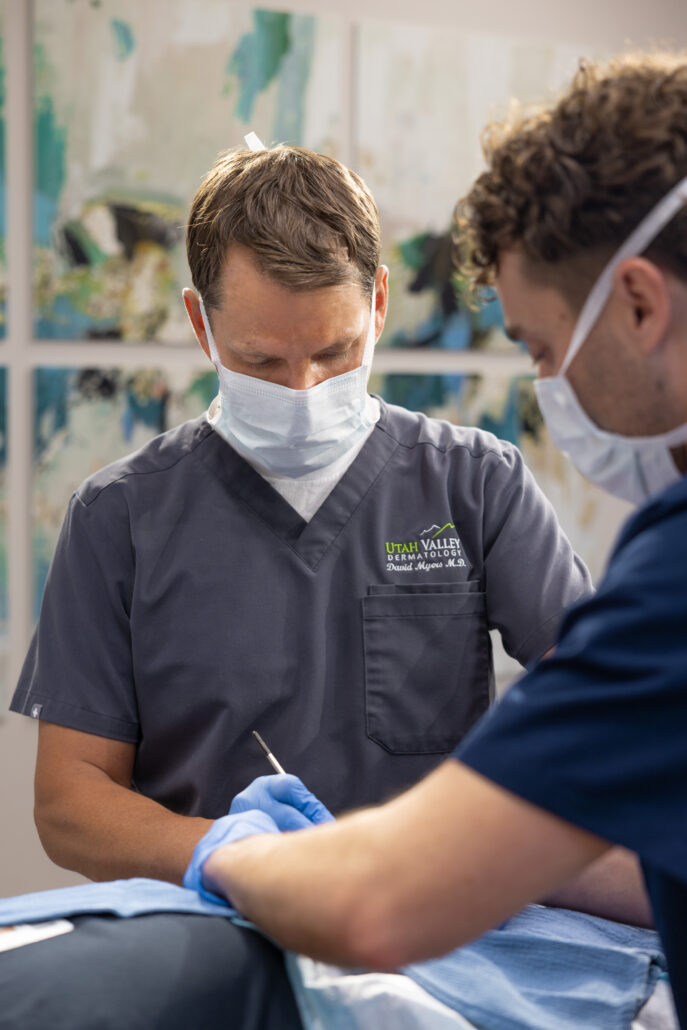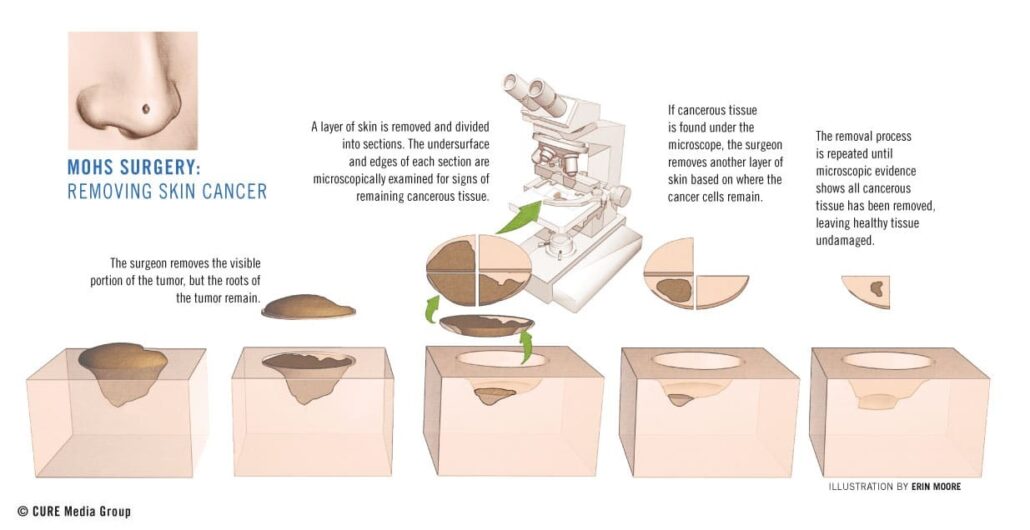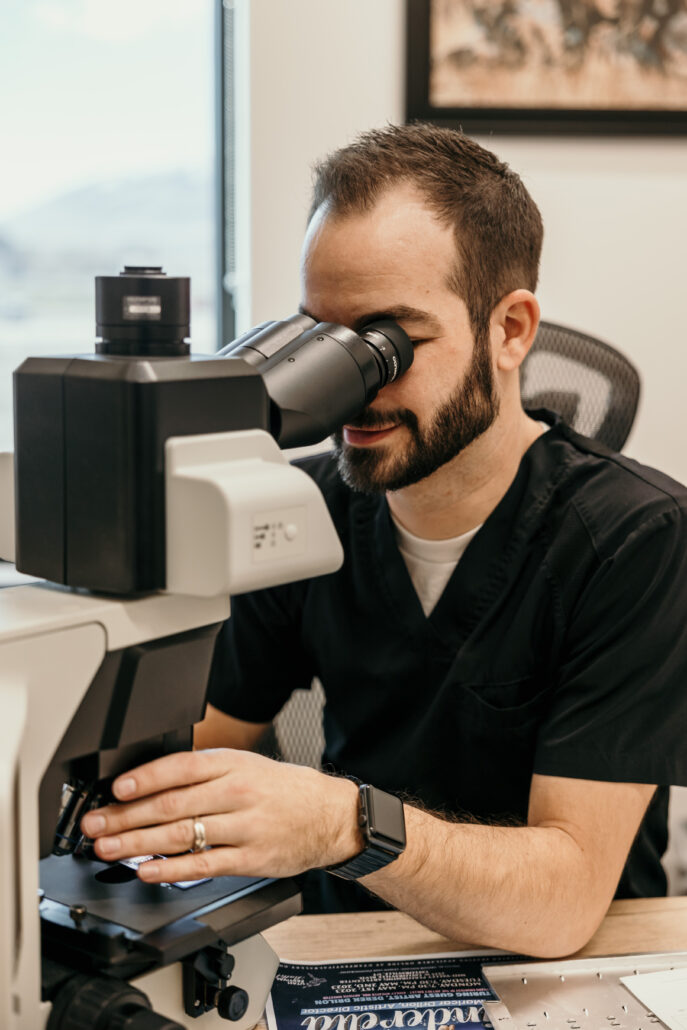MOHS SURGERY
A solution to skin cancer
What is Mohs Surgery?
MOHS surgery, otherwise known as Mohs micrographic surgery, is a highly specialized and precise surgical technique used for the removal of skin cancers, including basal cell carcinoma (BCC), squamous cell carcinoma (SCC), melanoma, and other less common types. This procedure is distinguished by its method of removing the cancerous tissue layer by layer and examining each layer under a microscope until all cancerous cells are eliminated. This method ensures a high success rate, offering up to a 99% cure rate for new cancers and 95% for recurring cancers.

How is Mohs Surgery Performed?
- Examination and Marking of the Cancerous Area: The procedure begins with the Mohs surgeon examining the visible lesion on the skin. The area around the tumor is then carefully marked with a pen to guide the removal.
- Local Anesthesia Application: The surgeon administers a local anesthetic to numb the region. This ensures that the patient is comfortable and pain-free throughout the procedure. The use of local anesthesia allows the patient to remain awake, which can be beneficial for immediate feedback and reduces the risks associated with general anesthesia.
- Sequential Removal of Skin Layers: The surgeon begins by removing the marked cancerous tissue along with a thin layer of surrounding skin. This tissue is then divided into sections, which are color-coded and mapped for precise analysis. The removed layer is known as the first “stage” of the surgery.
- Immediate Microscopic Examination: Each removed layer is quickly processed and examined under a microscope by the Mohs surgeon, who acts as both a surgeon and a pathologist. This immediate examination helps to assess whether cancer cells extend beyond the margins of the removed tissue.
- Continuation of Tissue Removal Until All Margins are Cancer-Free: If cancer cells are found at the margins, the surgeon removes another layer of tissue from the specific area where the cancer was detected, sparing other areas. This process is repeated, layer by layer, until microscopic examination shows no remaining cancer cells at the margins. This step is crucial for ensuring that all cancerous cells are removed while preserving as much healthy tissue as possible.

What are the benefits of Mohs Surgery?
High cure rates
Mohs surgery is renowned for its high cure rates. For new cases of BCC and SCC, Mohs surgery offers a cure rate of up to 99%, and for recurrent cancers, the cure rate is approximately 95%.
Minimal scarring
Another significant benefit of Mohs surgery is the preservation of healthy tissue, which leads to minimal scarring. Unlike traditional surgical methods that may require removing large areas of tissue to ensure all cancer cells are excised, Mohs surgery targets only the cancerous cells, sparing as much healthy tissue as possible. The result is not only a higher likelihood of complete cancer removal but also better cosmetic outcomes with minimal scarring.
Cost-effective
Mohs surgery is cost-effective and typically performed as an outpatient procedure under local anesthesia. This approach eliminates the need for hospital stays and the use of general anesthesia, reducing the overall cost of treatment. The efficiency of Mohs surgery, with its high cure rates and reduced need for additional treatments or surgeries, further contributes to its cost-effectiveness.

What Can You Expect During Recovery from Mohs Surgery?
General Timeline
The general timeline for recovery after Mohs surgery varies depending on the extent of the procedure, but most patients can expect a relatively quick recovery period. Typically, the initial healing of the surgical site occurs within a week to ten days. During the days following the surgery, patients may experience some swelling, bruising, or redness around the treated area, which usually subsides within a few days. It’s common for patients to report minor pain or discomfort, which can generally be managed with over-the-counter pain relievers such as acetaminophen or ibuprofen. Most patients are able to resume normal daily activities within a day after the surgery, although strenuous activities or heavy lifting should be avoided for a couple of weeks to facilitate healing.
Care Instructions
Care instructions for the surgical site are crucial for promoting proper healing and minimizing the risk of infection. Patients are typically advised to keep the wound clean and dry for at least 24 to 48 hours after the surgery. After this initial period, gentle washing with soap and water may be recommended. Applying an antibiotic ointment and covering the area with a bandage might also be necessary to protect the site. It’s important for patients to follow specific instructions provided by their surgeon regarding wound care to ensure optimal healing. Additionally, patients should avoid exposing the surgical site to direct sunlight, as UV exposure can affect the healing process and potentially worsen scarring.
Follow-up Visits
Follow-up visits are an essential part of post-operative care to monitor the healing of the surgical site and to check for any signs of recurrence. The first follow-up visit usually occurs a week after the surgery to assess the wound and remove any sutures, if necessary. Further periodic check-ups may be scheduled over the following months to a year, depending on the individual case. These visits allow the surgeon to ensure that the site is healing properly and to detect any early signs of recurrence. Given the high cure rates associated with Mohs surgery, recurrence is uncommon, but ongoing monitoring is crucial to managing and maintaining skin health.

How Can You Contact Us?
Interested in this procedure or have questions? Call or text us at (801) 768-8800, or click the contact button on this page!
TREATMENT OVERVIEW
TYPE:
- Skin Cancer
BENEFITS:
- Complete surgery and repair of the cancerous area
- Best treatment for both cosmetic and functional outcome
- Single visit outpatient surgery
RESULTS:
- Cure from skin cancers
- Minimal damage to surrounding tissue


